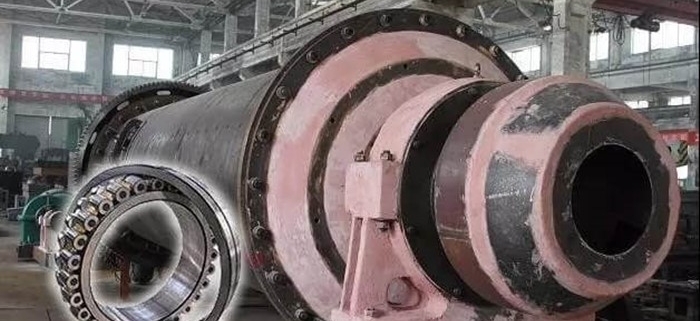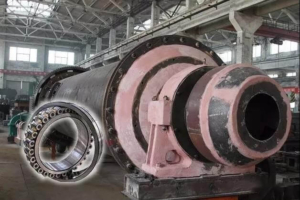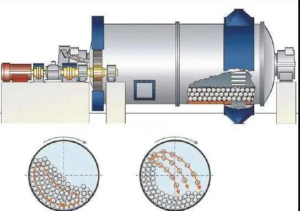Why the China bearing bush of supporter of rotary kiln heating?
When the sliding bearing works, a very thin oil film is required between the bearing bush and the shaft for lubrication. If the lubrication is poor, there will be direct friction between the bearing bush and the shaft, which will produce high temperature. Although the bearing bush is made of special high temperature resistant alloy material, the high temperature generated by direct friction is still enough to burn it out. The bearing bush may also burn due to excessive load, high temperature, impurities in lubricating oil or abnormal viscosity and other factors. The sliding bearing was damaged after burning.
As the “heart” equipment of cement plant, the operation quality of rotary kiln directly affects the production and operation efficiency of the whole cement plant.
Its power consumption is: heavy load, slow speed, high temperature, large temperature difference, outdoor operation, long-term operation in harsh environmental conditions. The kiln is lined with firebrick, the sintering temperature is thousands of degrees, the total weight of kiln is hundreds of tons, supported by six supporting wheels, each bearing bush of a supporting wheel bears dozens of tons on average, and the bearing bush of supporting wheel is often affected by impact load and adjustment.
Therefore, the heating phenomenon of the supporting wheel bearing bush is a common problem in the production and operation of the rotary kiln. If the heating of the bearing bush is not treated in time, it may cause the phenomenon of burning the bush. The best way to deal with the burning of the Bush is to scrape the bush again after the kiln is stopped. However, it usually takes about 3 days from the kiln temperature cooling down to the completion of the Bush re scraping, and it will take another 2 days from the kiln re ignition and temperature rise to the feeding, which has a serious impact on the production.
Common causes of heating of supporting wheel bearing bush
- The roller bearing shell is heated due to lubricating oil. If the lubricating oil of the bearing bush of the supporting wheel meets the oil change standard but does not change the oil, the viscosity of the lubricating oil will be reduced, or the oil will be emulsified, or the oil will contain dust and impurities, etc., which can cause the bearing bush to heat up.
- Bearing bush heating caused by oil leakage of supporting roller and falling off of lubricating device. Due to the poor sealing and serious oil leakage of the supporting axle, the oil level is reduced, or the lubricating oil scoop falls off and the lubrication is insufficient, which causes the temperature of the bearing bush to rise.
- The bearing bush is heated due to poor circulating water, small amount or water seepage of internal circulating water pipe. If the circulating water is not smooth or the amount is small, the poor effect of circulating cooling will cause the bearing bush to heat up. When the circulating water pipe inside the supporting wheel is aged and causes water leakage, the lubricating oil will be emulsified, the oil quality will be deteriorated, and the bearing bush will heat up.
- Temperature rise of bearing bush due to small clearance of bearing mouth. The contact angle between the bearing bush and the shaft becomes larger and larger when the supporting wheel bearing bush is used for a long time. At the same time, the contact clearance between the Bush mouth and the shaft becomes smaller and smaller. To a certain extent, the lubricating oil cannot enter the bottom of the Bush for lubrication, which causes the Bush to heat up.
- Temperature rise of bearing bush caused by stress concentration on the surface of wheel belt and supporting wheel. Under the condition of normal stress, the contact surface of the supporting wheel and the wheel belt should have the same bright color, and there is no obvious longitudinal bright and dark stripe on the wheel belt. If there are light and dark stripes, the bright side indicates that the bearing pad of the bearing pedestal is under stress, while the other side is under stress. If there is a gap between the dark stripe of the belt and the supporting wheel, and the area of the dark stripe is large, the bearing bush of the supporting wheel will generate heat.
- Temperature rise of bearing bush caused by large clearance between wheel belt and cylinder base plate. When the wear of the wheel belt and the cylinder base plate is serious and the gap between the wheel belt and the base plate is too large, the deformation ovality of the wheel belt increases. When the ovality of the wheel belt exceeds a certain value, it is easy to cause the heat of the supporting wheel bearing shell. At the same time, when the gap between the wheel belt and the cylinder base plate is too large, the contact surface between the two ends of the wheel belt and the supporting wheel changes, resulting in the uneven stress on the bearing pads on both sides of the supporting wheel, resulting in the bearing pad heating.
- The bearing bush heating caused by the running time of the hydraulic stop wheel. When the up speed of the hydraulic stop wheel is slow and uneven, and the down speed is too fast, a downward axial thrust is formed, which can also cause relative setback and friction between the supporting axle and the pad. When the contact clearance between a supporting wheel thrust plate and the end of the bearing bush is small, the bearing bush will be heated.
- The large radial temperature difference on the surface of kiln shell causes the heating of bearing bush. If the radial temperature difference of kiln is too large, the kiln will deform when it is over 100 ℃. When the cross-section of the cylinder is similar to that of the egg, it will cause the bearing shell of the supporting wheel to heat up.
- The relative deviation between the kiln center line and the supporting wheel axis causes the bearing bush to heat up. If there is a deviation between the kiln center line and a supporting wheel, when there is a positive “eight” or an inverted “eight”, when the rotary kiln cylinder is in the up or down direction, the supporting wheel with a deviation of the wheel belt pair will produce a larger axial force, which will cause the axial displacement of the supporting axle relative to the bearing, make the movement of the shaft appear radial rotation and axial movement, and break the original contact surface of the bearing bush, so as to Cause the surface of the supporting wheel bearing bush to heat up and produce wire drawing.
The heating problem of the bearing bush of the rotary kiln is the most common problem in the operation of the rotary kiln, and also the most annoying problem. There are many reasons for this, and there are many ways to deal with it. The correct choice of lubricating oil can not only avoid the heating phenomenon of the roller bearing bush and protect other equipment to the maximum extent, but also extend the use time of lubricating oil and save cost.





